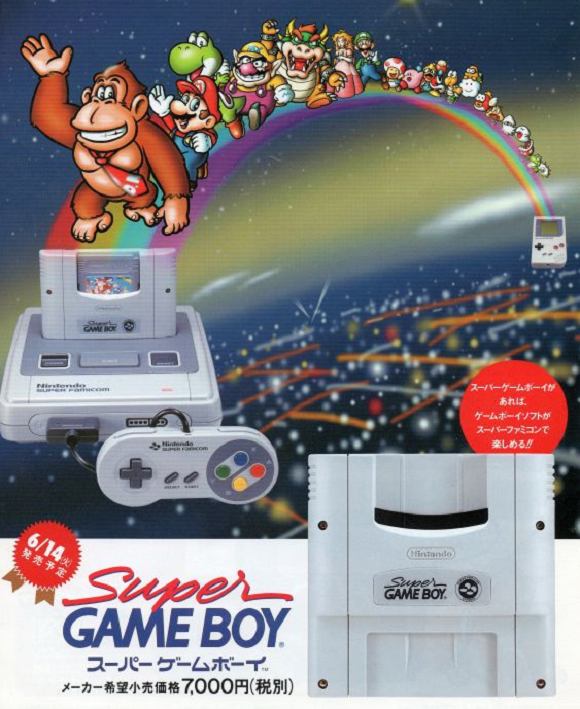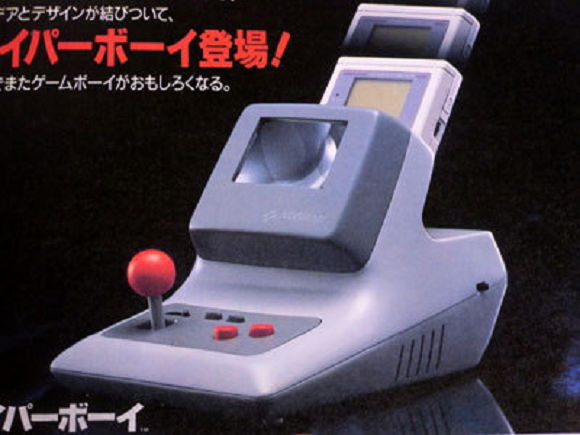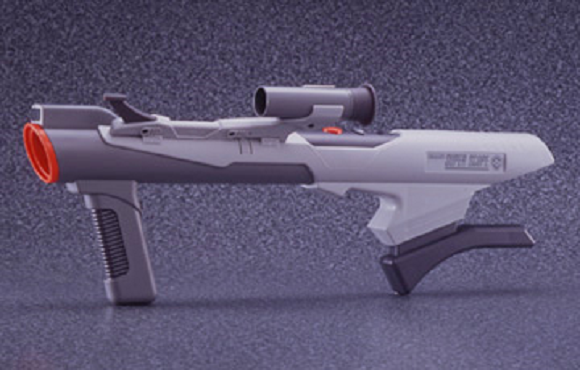One of the reasons I’ve done most of my video gaming with a console instead of a PC is the simplicity, on the consumer end, of the hardware. After plopping down the money for the system, you’re pretty much good to go, without the need to continually tinker with and incrementally upgrade it in order to play the latest games.
Still, that doesn’t mean everyone is satisfied to leave well enough alone in the console and handheld world, as evidenced by the piles of hardware add-ons that have been released over the years. Not every addition is a good one, though, as illustrated by the Japanese gamers who flocked to website Niconico News to share their video game peripheral horror stories.
In recent years, peripherals have become a little less common, so before we wade into the hardware add-on morass, here’s a little background on the subject. You can probably count the number of successful, satisfying peripherals from the 8 to 64-bit eras on one hand, and that’s even allowing for the possibility that you’ve been in a gruesome farm-equipment-related accident or two.
The Game Genie was a godsend for players looking to cheat or hack their way through a game. Perhaps the only bona fide peripheral success from a first party developer, the P.C. Engine’s CD-ROM add-on was a hit that extended the system’s life by several years in Japan, but was an eventual flop overseas.
Aside from that, peripherals have generally fallen into two categories:
1. Disappointments
2. Huge disappointments
Peripherals are usually designed to boost the power of a system. Nintendo’s Super Game Boy was billed as a way to enjoy improved versions of the titles for the company’s original handheld by adding a splash of color to the ordinarily monochrome graphics, plus displaying them on a full-size TV. Unfortunately, it did this by acting as a conduit to play Game Boy games on the vastly more powerful Super Famicom/Super NES, and many people saw the Super Game Boy as more of a downgrade to the latter than an upgrade to the former.
“I bought a Super Game Boy, but the additional color didn’t make the gameplay any better,” recalls one 34-yeard-old respondent, who would have been in junior high school when it hit stores in 1994. “It was a pain to hook up too, so I stopped using it pretty soon after I got it.”
This wasn’t the first attempt to enhance the Game Boy experience, though. Long before the Super Game Boy, there was the Hyper Boy.
Manufactured by Konami, the Hyper Boy had a slot for the entire Game Boy, cartridge and all, to slide into. Once in place, the magnifying glass provided larger graphics and the joystick more arcade-like controls….all while massively reducing the portability of the handheld. Maybe that’s why, as one dissatisfied customer said, “Almost nobody remembers it.”
Moving on to peripherals for regular consoles, the Super Famicom had a couple of stinkers, starting with the Super Scope.
Light guns in general have a dismal track record on home systems, as the limited nature of shooting games generally translates into an extremely small library of titles for them. The Super Scope was no exception, but at least, as one 30-year-old gamer remembers, it made an awesome bazooka if he unplugged it to use as a bazooka when he played soldiers with his friends.
The Japan-only Sufami Turbo wasn’t a rapid-fire controller, nor was it a Super Game Boy-style converter to play TurboGrafx-16 games on Nintendo’s 16-bit console. Instead, the Bandai-made Super Famicom peripheral contained two cartridge slots, one of which could hold base programming for games, and the second of which could be used for low-cost add-ons with new maps and levels.
In some ways, it was a less elegant precursor to the downloadable content that’s provided so much lifeblood to the game industry today, but in 1996, the Sufami Turbo was an idea ahead of its time on a system past its prime. The very last Sufami Turbo game was released just three months after the peripheral went on sale, leaving its mercifully small user base high and dry.
At least in the case of the Sufami Turbo, Bandai can use its lack of console hardware as an excuse. It’s a little harder to wrap your head around the sudden collapse of Nintendo’s own 64DD. Also known as the Bulky Drive, the DD was a disk drive for the Nintendo 64, whose reliance on cartridges was becoming an increasingly crippling handicap in its fight against the CD-based PlayStation.
Launched in December of 1999, the DD didn’t end up as laughably short-lived as the Sufami Turbo, but it didn’t last much longer either, with its last release coming just eight months later. In all, just nine DD titles were made, which might not have been such a bad deal had they all been A-plus-quality games.
Unfortunately, the complete DD library included one expansion pack that required an existing Nintendo 64 cartridge to play, a golf game, four different Mario Artist packs, and SimCity 2000 (which also had versions on any number of competing systems). The only games of any real interest were the quirky god-simulator Doshin the Giant, and the Doshin the Giant expansion. Doshin would later get a rerelease on the Nintendo GameCube, clearing away almost any reason for anyone to buy a DD (not that there was much of one in the beginning).
A harsh critic could argue that the 64DD was the result of Nintendo taking a wild shot in the dark to try to slow down the juggernaut the PlayStation had become. Sony’s storied system had peripheral snafus of its own, though, which were sometimes triggered as much by the exuberance from its massive lead as Nintendo’s were by its flailing attempts to play catch up.
Namco’s NeGCon was pushed as a great way to play driving games like the company’s then-hit Ridge Racer series. Twisting the controller allowed for analog steering, and certain buttons were also analog, enabling precise presses of the accelerator or brakes. What wasn’t so fun, though, was a lack of L2 and R2 triggers, or a select button for that matter. Even worse, since the NeGCon was launched at the same time as the PlayStation itself, games weren’t yet at a level of sophistication to implement that level of control. “I bought one, but I always got slower times when I used it,” grumbled one respondent.
Sony itself would go reaching a bit too far with the PocketStation, a souped-up version of the PlayStation’s memory card which was released in 1999.
With a small black and white screen, tiny cross pad, and single action button, Sony optimistically thought gamers would want to play mini games on the PocketStation even while they could instead be spending time with Final Fantasy VIII, Resident Evil 3, and Silent Hill.
Whereas the PocketStation was ostensibly trying to appeal to gamers by looking fun, the controller for Capcom’s Steel Battalion did everything it could to look cool.
With control sticks, buttons, switches, and even pedals everywhere, the controller for Steel Battalion, which, we have to stress, was only usable with this game and its sequel, pumped the total cost of the title up to 19,800 yen (US $196). For shelling out enough cash to buy four ordinary games, the controller would make you feel like a real mech pilot…
…provided you actually had someplace to set it up, that is. The oversized contraption made Steel Battalion impossible to play while chilling on the couch. For the many gamers who lacked the space for a dedicated warmech staging facility in their apartments, the experience turned sour quickly. “I bought it, but I had no place to put it,” remembers one gamer.
Awesome-looking and full of promises it could never actually deliver on, it was basically the second coming of the Power Glove. No wonder when Capcom finally decided to make a third Steel Battalion game in 2012, they decided to give it motion controls instead.
Source: Niconico News
Insert images: Freett, Ameblo, All About




 The 20 most fun PlayStation titles, as picked by Japanese gamers
The 20 most fun PlayStation titles, as picked by Japanese gamers Mario welcomes the PlayStation 4 to Japan like a gang leader protecting his turf
Mario welcomes the PlayStation 4 to Japan like a gang leader protecting his turf Retro freak: the new system that lets you play cartridges from 11 different classic game consoles
Retro freak: the new system that lets you play cartridges from 11 different classic game consoles Lonely this Christmas: Japanese gamers feeling left out in the cold as new consoles launch elsewhere
Lonely this Christmas: Japanese gamers feeling left out in the cold as new consoles launch elsewhere Sony officially announces pricing for PlayStation VR add-on for PlayStation 4
Sony officially announces pricing for PlayStation VR add-on for PlayStation 4 7-Eleven Japan’s ramen-cooking robot whipped us up a bowl of noodles【Taste test】
7-Eleven Japan’s ramen-cooking robot whipped us up a bowl of noodles【Taste test】 Is it rude to sing along at concerts in Japan? We ask a pro musician for his take
Is it rude to sing along at concerts in Japan? We ask a pro musician for his take Japanese avoiding domestic travel as foreign tourists increase, possibly creating vicious cycle
Japanese avoiding domestic travel as foreign tourists increase, possibly creating vicious cycle Japan’s otoshidama tradition of giving kids money at New Year’s gets a social welfare upgrade
Japan’s otoshidama tradition of giving kids money at New Year’s gets a social welfare upgrade Daiso unveils new official mascot, Daizo the elephant
Daiso unveils new official mascot, Daizo the elephant The 10 best day trips from downtown Tokyo【Survey】
The 10 best day trips from downtown Tokyo【Survey】 Three ways the unauthorized U.S. Department of Homeland Security Pokémon video makes no sense
Three ways the unauthorized U.S. Department of Homeland Security Pokémon video makes no sense Lawson now sells old rice as “vintage” onigiri in Japan
Lawson now sells old rice as “vintage” onigiri in Japan Duolingo to open first pop-up store Duomart in Japan for a very limited time next month
Duolingo to open first pop-up store Duomart in Japan for a very limited time next month Starbucks Japan unveils new Sakura Frappuccino for cherry blossom season 2025
Starbucks Japan unveils new Sakura Frappuccino for cherry blossom season 2025 7-Eleven Japan starts new temporary luggage storage service in over 300 branches
7-Eleven Japan starts new temporary luggage storage service in over 300 branches Disillusionment at Tsukiji’s tourist-target prices led us to a great ramen restaurant in Tokyo
Disillusionment at Tsukiji’s tourist-target prices led us to a great ramen restaurant in Tokyo Starbucks teams up with 166-year-old Kyoto doll maker for Year of the Horse decorations【Photos】
Starbucks teams up with 166-year-old Kyoto doll maker for Year of the Horse decorations【Photos】 Japan may add Japanese language proficiency, lifestyle classes to permanent foreign resident requirements
Japan may add Japanese language proficiency, lifestyle classes to permanent foreign resident requirements Starbucks Japan releases new zodiac chilled cup drink for 2026
Starbucks Japan releases new zodiac chilled cup drink for 2026 Lacquerware supplier to emperor of Japan and Pokémon team up for new tableware
Lacquerware supplier to emperor of Japan and Pokémon team up for new tableware Tokyo’s Tsukiji sushi neighborhood asks tour groups to stay away for the rest of the month
Tokyo’s Tsukiji sushi neighborhood asks tour groups to stay away for the rest of the month Is this the most relaxing Starbucks in Japan?
Is this the most relaxing Starbucks in Japan? Starbucks on a Shinkansen bullet train platform: 6 tips for using the automated store in Japan
Starbucks on a Shinkansen bullet train platform: 6 tips for using the automated store in Japan Street Fighter Hadouken Churros to be launched and eaten in Tokyo, Okami pudding on offer too
Street Fighter Hadouken Churros to be launched and eaten in Tokyo, Okami pudding on offer too Japan’s human washing machines will go on sale to general public, demos to be held in Tokyo
Japan’s human washing machines will go on sale to general public, demos to be held in Tokyo Japanese train company is letting fans buy its actual ticket gates for their homes
Japanese train company is letting fans buy its actual ticket gates for their homes Tokyo considering law requiring more trash cans following litter increase in heavily touristed area
Tokyo considering law requiring more trash cans following litter increase in heavily touristed area Nintendo’s Kirby now delivering orders at Kura Sushi restaurants, but not in Japan
Nintendo’s Kirby now delivering orders at Kura Sushi restaurants, but not in Japan Tokyo event lets you travel back in time, for free, to celebrate 100 years since Showa era start
Tokyo event lets you travel back in time, for free, to celebrate 100 years since Showa era start Sanrio theme park in Japan announces plans to expand into a Sanrio resort
Sanrio theme park in Japan announces plans to expand into a Sanrio resort Survey asks foreign tourists what bothered them in Japan, more than half gave same answer
Survey asks foreign tourists what bothered them in Japan, more than half gave same answer Japan’s deadliest food claims more victims, but why do people keep eating it for New Year’s?
Japan’s deadliest food claims more victims, but why do people keep eating it for New Year’s? We deeply regret going into this tunnel on our walk in the mountains of Japan
We deeply regret going into this tunnel on our walk in the mountains of Japan Studio Ghibli releases Kodama forest spirits from Princess Mononoke to light up your home
Studio Ghibli releases Kodama forest spirits from Princess Mononoke to light up your home Major Japanese hotel chain says reservations via overseas booking sites may not be valid
Major Japanese hotel chain says reservations via overseas booking sites may not be valid Put sesame oil in your coffee? Japanese maker says it’s the best way to start your day【Taste test】
Put sesame oil in your coffee? Japanese maker says it’s the best way to start your day【Taste test】 The top 10 annoying foreign tourist behaviors on trains, as chosen by Japanese people【Survey】
The top 10 annoying foreign tourist behaviors on trains, as chosen by Japanese people【Survey】 No more using real katana for tourism activities, Japan’s National Police Agency says
No more using real katana for tourism activities, Japan’s National Police Agency says Starbucks Japan reveals new sakura drinkware collection, inspired by evening cherry blossoms
Starbucks Japan reveals new sakura drinkware collection, inspired by evening cherry blossoms Sony Unveils its Vision for the Future of Video Games with PlayStation 4
Sony Unveils its Vision for the Future of Video Games with PlayStation 4 Instead of waiting for Nintendo’s Switch, this awesome gamer made his own portable Super Famicom
Instead of waiting for Nintendo’s Switch, this awesome gamer made his own portable Super Famicom Super NES Classic Edition announced, brings back the ‘90s in more ways than you can imagine
Super NES Classic Edition announced, brings back the ‘90s in more ways than you can imagine Six-button Switch! Japanese gadget company turns Nintendo’s console into retro arcade controller
Six-button Switch! Japanese gadget company turns Nintendo’s console into retro arcade controller Cute little gamer knows the score【Video】
Cute little gamer knows the score【Video】 Japan’s most popular game console: PS4 sales to surpass Wii U
Japan’s most popular game console: PS4 sales to surpass Wii U The “Nintendo PlayStation”: a look at the console that could’ve changed gaming history【Video】
The “Nintendo PlayStation”: a look at the console that could’ve changed gaming history【Video】 Classic 16-bit Nintendo controllers get modern makeover for use with Switch, current-gen consoles
Classic 16-bit Nintendo controllers get modern makeover for use with Switch, current-gen consoles Rumour: PlayStation 4 camera to be sold separately
Rumour: PlayStation 4 camera to be sold separately Sony’s PlayStation turns 20 years old, we look back at how it all began and the games we loved
Sony’s PlayStation turns 20 years old, we look back at how it all began and the games we loved Super Smash Bros. has pathetically small grand prize at Japan’s biggest fighting game tournament
Super Smash Bros. has pathetically small grand prize at Japan’s biggest fighting game tournament Nintendo Museum’s official merch includes awesome giant controller cushions【Video】
Nintendo Museum’s official merch includes awesome giant controller cushions【Video】 Using our brand new Xbox One console… to play New Super Mario Bros. Wii U
Using our brand new Xbox One console… to play New Super Mario Bros. Wii U Nintendo FINALLY adds 16-bit Super NES/Super Famicom games to Switch Online service!
Nintendo FINALLY adds 16-bit Super NES/Super Famicom games to Switch Online service!
Leave a Reply